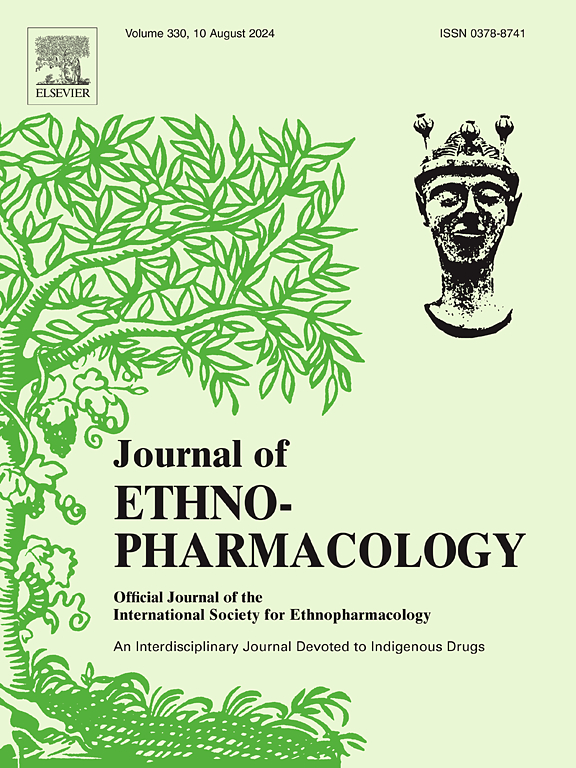Investigation of the effect and mechanism of Fei Re Pu Qing powder in treating acute lung injury (ALI) by modulating macrophage polarization via serum pharmacology and network pharmacology
IF 5.4
2区 医学
Q1 CHEMISTRY, MEDICINAL
引用次数: 0
Abstract
Ethnopharmacological relevance
Acute lung injury (ALI) is a clinical critical illness characterized by progressive pulmonary inflammatory response and high mortality. An increasing number of studies have confirmed that traditional Chinese medicine (TCM) and compound prescriptions hold considerable promise in the prevention and treatment of respiratory inflammatory diseases. Fei Re Pu Qing Powder (FRPQ) is an efficacious prescription used in clinical treatment of pneumonia in Tibet, China. Its potential effects and mechanisms on ALI are worthy of further study.
Aim of the study
This study aims to characterize the bioactive constituents of FRPQ and elucidate its potential target sites and underlying mechanisms of action in ALI.
Materials and methods
Firstly, the pharmacodynamic effects of FRPQ were assessed using an LPS-induced rat model of ALI. Subsequently, the optimal pharmacodynamic dose was determined for a time-course study to evaluate the onset and duration of FRPQ's pharmacological actions. Based on the identification of potential active components in FRPQ-containing serum using UHPLC-Q Exactive HFX, core components, key targets, and signaling pathways were systematically screened via network pharmacology approaches. Subsequently, molecular docking analysis was performed on the identified core components and key targets to validate their binding activity and affinity. Finally, the potential mechanism underlying its effect on ALI was further verified using the ALI rat model and the M1/M2 polarization model of NR8383 cells.
Results
FRPQ exerts rapid and long-lasting effects on ALI rats. 63 prototype components of FRPQ were identified in the drug-containing serum, among which 25 have potential activity. An active components - intersection targets - ALI network was constructed, and 6 core components (Kaempferol, Piperine, Phloretin, etc.) were selected. PPI analysis identified 9 targets closely related to the therapeutic effect of ALI. GO/KEGG analysis indicated that FRPQ treatment of ALI is closely related to multiple inflammatory signaling pathways. Molecular docking showed that the binding energy of the 6 core components with the 9 core targets was ≤ −5.4 kcal/mol, indicating strong binding affinity. In vivo experiments showed that FRPQ could significantly reduce macrophage infiltration in the lung tissue of ALI rats, effectively down-regulate the expression of NF-κB/p65 protein, and the changes in the transcriptional levels of inflammatory mediators in lung tissue and the content of inflammatory factors in alveolar lavage fluid further verified the regulatory effect of FRPQ on the NF-κB signaling pathway. In vitro experiments showed that the drug-containing serum significantly inhibited the polarization of NR833 cells to the M1 phenotype and promoted their polarization to the M2 phenotype. The inhibition of M1 polarization may be achieved through negative regulation of the NF-κB signaling pathway, providing potential mechanism support for the treatment of ALI.
Conclusions
This study systematically analyzed and preliminarily elucidated the active components of FRPQ and their potential mechanisms of action by integrating serum pharmacology with network pharmacology approaches. The findings indicate that FRPQ may contribute to the treatment of ALI through the regulation of the NF-κB signaling pathway and the modulation of macrophage M1/M2 polarization. This advancement offers critical experimental evidence and theoretical underpinnings for the further development and clinical application of FRPQ.

从血清药理学和网络药理学角度探讨肺热璞清散调节巨噬细胞极化治疗急性肺损伤的作用及机制
急性肺损伤(acute lung injury, ALI)是一种以进行性肺部炎症反应和高死亡率为特征的临床危重疾病。越来越多的研究证实,中药和复方在预防和治疗呼吸道炎症性疾病方面具有相当大的前景。肺热璞清散是中国西藏地区临床治疗肺炎的有效方剂。其对ALI的潜在作用和机制值得进一步研究。本研究旨在表征FRPQ的生物活性成分,阐明其在ALI中的潜在靶点和作用机制。材料与方法首先,采用lps诱导的ALI大鼠模型,评价FRPQ的药效学作用。随后,确定最佳药效学剂量,进行时间过程研究,以评估FRPQ药理作用的起效和持续时间。在UHPLC-Q Exactive HFX技术鉴定含frpq血清潜在活性成分的基础上,通过网络药理学方法系统筛选核心成分、关键靶点和信号通路。随后,对鉴定出的核心组分和关键靶点进行分子对接分析,验证其结合活性和亲和力。最后,利用ALI大鼠模型和NR8383细胞M1/M2极化模型进一步验证其对ALI作用的潜在机制。结果frpq对ALI大鼠有快速、持久的作用。在含药血清中鉴定出63种FRPQ原型成分,其中25种具有潜在活性。构建活性成分-交叉靶点- ALI网络,筛选出6个核心成分(山奈酚、胡椒碱、根皮素等)。PPI分析确定了9个与ALI治疗效果密切相关的靶点。GO/KEGG分析表明,FRPQ治疗ALI与多种炎症信号通路密切相关。分子对接表明,6个核心组分与9个核心靶点的结合能≤−5.4 kcal/mol,具有较强的结合亲和力。体内实验表明,FRPQ可显著降低ALI大鼠肺组织巨噬细胞浸润,有效下调NF-κB/p65蛋白表达,肺组织炎症介质转录水平及肺泡灌洗液炎症因子含量的变化进一步验证了FRPQ对NF-κB信号通路的调节作用。体外实验表明,含药血清显著抑制NR833细胞向M1表型极化,促进其向M2表型极化。抑制M1极化可能通过负调控NF-κB信号通路实现,为ALI的治疗提供潜在的机制支持。结论采用血清药理学与网络药理学相结合的方法,系统分析并初步阐明了FRPQ的有效成分及其可能的作用机制。提示FRPQ可能通过调节NF-κB信号通路和调节巨噬细胞M1/M2极化参与ALI的治疗。这一进展为FRPQ的进一步发展和临床应用提供了重要的实验证据和理论基础。
本文章由计算机程序翻译,如有差异,请以英文原文为准。
求助全文
约1分钟内获得全文
求助全文
来源期刊

Journal of ethnopharmacology
医学-全科医学与补充医学
CiteScore
10.30
自引率
5.60%
发文量
967
审稿时长
77 days
期刊介绍:
The Journal of Ethnopharmacology is dedicated to the exchange of information and understandings about people''s use of plants, fungi, animals, microorganisms and minerals and their biological and pharmacological effects based on the principles established through international conventions. Early people confronted with illness and disease, discovered a wealth of useful therapeutic agents in the plant and animal kingdoms. The empirical knowledge of these medicinal substances and their toxic potential was passed on by oral tradition and sometimes recorded in herbals and other texts on materia medica. Many valuable drugs of today (e.g., atropine, ephedrine, tubocurarine, digoxin, reserpine) came into use through the study of indigenous remedies. Chemists continue to use plant-derived drugs (e.g., morphine, taxol, physostigmine, quinidine, emetine) as prototypes in their attempts to develop more effective and less toxic medicinals.
 求助内容:
求助内容: 应助结果提醒方式:
应助结果提醒方式:


